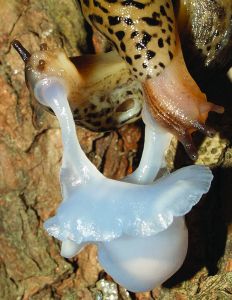|
The well known and often photographed mating of the slug Limax maximus takes place whilst a couple is suspending itself with mucus from an elevated point, commonly a tree branch or a wall (Örstan, 2008). Adams (1898) published the first detailed description of this process, although there were a few earlier and shorter accounts of it, the very first one apparently being that of Martin Lister published in 1678 (Isabel Hyman, in litt.). Recently, during a search of Google Books (http://www.books.google.com) for the occurrences of the phrase “limax maximus”, I discovered a description of the mating of that species in James Barbut's The genera Vermium exemplified by various specimens of the animals contained in the orders of the Intestina et Mollusca Linnaei, published in London in 1783. As far as I can tell, Barbut’s account of the mating of L. maximus has not been noted before. Barbut's 101-page book is bilingual with each page carrying text both in English and French; in addition, brief descriptions of the orders and genera are given in Latin. Scattered throughout are 11 plates of illustrations drawn by Barbut as noted on the cover of the book. Barbut’s description of the genus Limax, closely following the original of Linnaeus (1758), is as follows: “The body is long, creeping; has over it a kind of buckler made of flesh; underneath a longitudinal flat disk. There is a hole on the right side, for the genitals and evacuations. The feelers are four in number, placed above the mouth.” The “buckler” is, undoubtedly, the mantle, but it is not clear if the “longitudinal flat disk” refers to the internal vestigial shell of the slugs in the genus Limax or to the sole of the foot. Linnaeus‘s corresponding statement was also equivocal. The hole on the right side that Barbut (and Linnaeus before him) observed was most likely the conspicuous pneumostome, the breathing hole that is visible in Barbut’s drawing of L. maximus (Figure 1). The openings of the rectum and the ureter are next to it, but the genital opening is separate and closer to the front of the head and is normally kept closed except during mating (Figure 2). The misidentification of the pneumostome as the genital opening was an oversight of Linnaeus that Barbut perpetuated. This is how Barbut outlined the mating of slugs: “Their coming together is towards the end of spring. The organs of generation are placed, as in the snail, on the right side of the neck. The male implement unfolds with the same mechanism, as the finger of a glove when turned inside out. They are sometimes met with hanging in the air with their heads downwards, their tails united by a kind of viscous and thick tie, are grappled to the branch of a tree. In this situation they remain for three hours, and that is the instant of impregnation.” Barbut also gave brief accounts of the four species of slugs that were known from Great Britain at that time and which Linnaeus had described in 1758. These were Limax ater (now Arion ater), Limax rufus (now Arion rufus), Limax maximus and Limax flavus. Although Barbut did not specify which of those four slug species mated in the manner he described, we can deduce that his description was for L. maximus, because unlike L. maximus, the two Arion species and L. flavus all mate on the ground (Quick, 1960). Barbut’s brief description of the eversion of a slug’s penis is remarkably accurate. Moreover, whilst discussing L. ater, he states correctly that “it is an [sic] hermaphrodite, both sexes being in each individual, and both in the coitus impregnate, and are impregnated, at the same time.” However, Barbut did not state if these were his original observations or were taken from the literature. A search of the Internet for biographical information about Barbut revealed only one relevant source, Damkaer's Copepodologist's Cabinet (2002). Damkaer, however, had very little to say about Barbut: “I am surprised that there is apparently no substantial biographical material about Barbut. Even the Dictionary of National Registry has no entry...The date of Barbut’s death is from the library catalog of the Wellcome Institute. Barbut’s (1783) preface, in which he states that he would appreciate specimens from anyone, gave his home as ‘Walcot Place, Lambeth,’ likely a London district.” Damkaer could not determine Barbut’s birth year and gave his death year tentatively as 1791. Barbut appears to have been an enthusiastic naturalist and a talented scientific illustrator. Although his works have survived, he himself has unfortunately become an unknown. References Adams, L. E. 1898. Observations on the pairing of Limax maximus. Journal of Conchology 9: 92-95. Barbut, J. 1783. The genera Vermium exemplified by various specimens of the animals contained in the orders of the Intestina et Mollusca Linnaei. (The 1783 edition is available in the Biodiversity Heritage Library, http://tinyurl.com/bwvb4v; the 1794 edition in Google Books, http://tinyurl.com/b8mndb) Damkaer, D.M. 2002. The Copepodologist's Cabinet: A Biographical and Bibliographical History. American Philosophical Society. Philadelphia. Linnaeus, C. 1758. Systema Naturae. (http://tinyurl.com/7ouv4x) Lister, M. 1678. Historiae animalium Angliae tres tractatus. Unus de Araneis. Alter de Cochleis tum terrestribus tum fluviatilibus. Tertius de Cochleis marinis. Quibus adjectus est quartus de Lapidibus ejusdem insulae ad cochlearum quandam imaginem figuratis. (http://tinyurl.com/7r4mdn) Örstan, A. 2008. Limax maximus mating—part 2. Snail’s Tales, 14 February 2008. http://tinyurl.com/2shmf7 Quick, H. E. 1960. British slugs (Pulmonata, Testacellidae, Arionidae, Limacidae). Bulletin of the British Museum (Natural History) 6: 103-226. |
Figure 1: Limax maximus from Barbut’s Plate III.
Figure 2: A pair of Limax maximus mating on the trunk of a pine tree in Maryland, USA. The separate locations of the genital opening out of which the penis was everted and the pneumostome, the large hole to the right of the former, are clearly visible along the right side of the head of the slug in the back.
|
An eighteenth century description of the mating of Limax maximus
Issue
19
Page
10
Species


